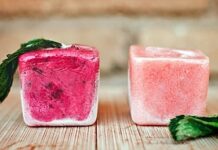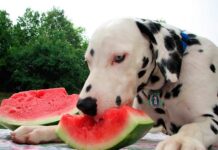We live in a world where a good marketing campaign can make us believe that we are giving our dogs an excellent dog food, when in reality we are slowly poisoning them. This, combined with the lax regulations of the dog food industry, where animal byproduct can be labeled as “fresh meat”, means we need to take a closer look at what we are really feeding our dogs.
Figuring out the quality of a particular dog food is much easier than you might think. All you have to do is review the ingredients label and use the tips in this article to know if you’re looking at a dog food made of high quality ingredients, or a food that you shouldn’t be giving to your pet.
If you can devote just five minutes of your time to learn a bit more about your dog’s nutrition, I assure you that after reading this post, you’ll know exactly how to identify a good quality dog food versus a poor quality one.
On the other hand, if you’re one of those people who would rather invest their time in watching trash TV or spending your money getting wasted every weekend instead of thinking about your dog’s nutrition and buying him a decent dog food… well, you don’t need to keep reading. For everyone else, hang on to your hats, because what you’re about to read will shock you.

The plague of the 21st century: Dog food marketing
If someone asked you, “What is marketing?” your answer would most likely be that it’s the art of making a product sell better. Highlighting its qualities and looking for catchy slogans or jingles to advertise it while briefly explaining its many features or benefits.
It would be fantastic if it were that simple, but unfortunately marketing is also the art of selling terrible products as if they were super premium quality. In other words, the art of legally deceiving consumers. This practice allows them to make fast profits, since they are selling a very low quality and low production cost product as if it were a high quality one.
There are marketing degrees, companies that are dedicated exclusively to marketing, and even worldwide advertising campaigns. Never underestimate the power of an ad campaign, because they are capable of making you see something that doesn’t actually exist.
Excessively lax government and lack of regulatory standards
It sounds crazy, but the truth is that the government is largely to blame for all this. They are ridiculously permissive with dog food manufacturers, and the lack of laws regulating the composition and labeling of these products allows companies to avoid clearly labeling the composition of their foods.
For example, if I, as a dog food manufacturer (just as an example) use the byproducts or leftovers from slaughterhouses to make my food, which is very common, I can put on the label that my food is made of fresh meat. Likewise, I can say my food is made of the highest quality meat even though I’m really using meat byproduct meal (we’ll look at that later).
In short, I can be deceptive with the description on the packaging or simply say “half-truths” without fearing any repercussions, because it’s legal. Did you think your dog’s food was made with high quality meat?
The AAFCO ingredient definitions are helpful for pet owners in the United States who want to research what is in their pet’s food (http://www.aafco.org/Consumers/What-is-in-Pet-Food). You can also look at the FDA Animal Feed Safety System, and Section 21 of the Code of Federal Regulations, Part 573, Food Additives Permitted in the Feed and Drinking Water of Animals.

Raw materials used to manufacture dog food
In order to understand what I’m going to explain later, we need to know some things about the raw materials that are generally used in the manufacture of pet food. The first thing you need to do is reset your brain and understand that no dog food is made with tenderloin, but with leftovers that aren’t fit for human consumption.
Meat as an ingredient on dog food labels
There are many types of meat when it comes to buying dog food, even if they’re all from the same animal. As an example, let’s look at chicken, which can be found as:
- Chicken
- De-boned chicken
- Chicken meal
- Chicken by-product
- Chicken by-product meal
Yikes… that’s a lot of variations just to list chicken as an ingredient. The same happens if the meat used is pork, beef, lamb, duck or many others… there are the same variables for each type of animal.
If the label says chicken, according to the AAFCO, this means “the clean combination of flesh and skin with or without accompanying bone, derived from the parts or whole carcasses of chicken or a combination thereof, exclusive of feathers, heads, feet and entrails.” De-boned chicken would be the same thing, but without the bones.
If the label says “chicken by-product”, you should know that this does not refer to breasts and thighs, but any other part of the chicken that can’t be sold for human consumption, including heads, necks, feet, undeveloped eggs and intestines, other internal organs, etc., but does not include feathers.
The word “meal” means the product has been treated with heat and/or pressure to remove most of the water and fat. In this case, “chicken by-product meal” is possible the worst quality you can find when it comes to adding meat to dog food. Among all the possible ways of putting meat in pet food, “by-product meal” is the lowest quality.
 Grains and carbohydrates on dog food labels
Grains and carbohydrates on dog food labels
There are many opinions regarding whether it is or is not recommendable to use grains or tubers as carbohydrates in dog food. Personally, I admit that I prefer to avoid any food that contains grains or tubers, but given the scarcity of foods without them, I have used them on occasion, always aiming for a minimal level of grains or tubers.
Many manufacturers use tricks when listing ingredients on their labels, since by law they are required to put them in order of percentage, from greatest to least quantity.
To avoid putting corn, for example, as the first ingredient on a type of dog food, they will often use tricks like: “Pork 30%, Corn 20%, Corn starch 15%, etc.” Here you can see that the total of corn and its derivatives is 35% (20% corn + 15% corn starch). So this food really should put on its label “Corn and derivatives 35%, Pork 30%, etc.”
If that weren’t enough, if you consider the amount of water and fat in the meat, 30% of chicken is really only 6% dry weight. In other words, that entire bag of food really contains less chicken than a chicken McNugget.
You see how easy it is to manipulate a label? That’s why it’s extremely important to be familiar with the ingredients and know how to analyze them.
The same goes for rice or potato. If for example the label says “Chicken meal 30%, Rice 20%, Potato 15%…” if you add up the carbohydrates, the rice and potato, you get 35% compared to 30% of the chicken meal. In other words, you’re paying for dog food that is mostly made of carbohydrates. Like the TV commercials say, buyer beware!
Personally I don’t think a dog food needs completely unnecessary grains and tubers, but if it does contain them, they should not exceed 10% of the total composition of the food combined.
 Fruits, vegetables and magic herbs on dog food labels
Fruits, vegetables and magic herbs on dog food labels
Much of the fruit that we humans regularly eat is also suitable and healthy for our dogs (without the core and seeds). The same goes for vegetables and some herbs that are often used in traditional cooking.
But just because you see a picture of fruits and vegetables on the bag doesn’t mean the food contains them in any meaningful way. In general, they only use the peels or leftovers that aren’t fit for human consumption, although in some cases they will use whole fruit… but in such low percentages and after accounting for the water lost in dehydration… in reality, your dog will get more fruit from something he finds on the floor than the total amount in the bag of dog food.
The truth is that most fruit is healthy for dogs, but always fresh and fit for human consumption. Never dehydrated or mechanically separated or powdered… remember, buyer beware!! So really, you shouldn’t pay too much attention to this ingredient.
Something similar happens for vegetables, although because they are much cheaper it’s possible to find them as vegetable fiber or certain vegetables, specifying that they are healthy for dogs. Of course they are healthy for dogs, but when given fresh and clean, as if they were for a human to eat… the ones that come in a bag of dog food, you’d best not think too hard about where they come from. Vegetables are also used as filler to make the food cheaper, just like potato or any other tuber or grain.
Magic herbs and oysters from the North Pole… more of the same. In small quantities and always fresh, they can be beneficial for a dog, but a bag of dog food isn’t fresh and certainly isn’t suitable for human consumption.

How to interpret the ingredients list on any bag of dog food
Now is the moment of truth, and since you know that by law ingredients must be listed in order, and also the tricks that are used to trick consumers, now let’s look at real, practical examples of dog food ingredients.
The vast majority of dog foods have the ingredients list on the back, on a side or in some cases even on the front. All of them have an ingredients label because it’s required by law, so let’s take advantage of it.

Here you can see that the main ingredients in order from largest to smallest quantity are: Ground yellow corn, chicken by-product meal, corn gluten meal, whole wheat flour, etc.
This is a very, very low quality dog food. The main ingredients are grains and if that weren’t enough, they’ve even separated Corn and Corn Gluten Meal… see it to believe it. Furthermore, the meat comes from by-products (the worst) and on top of that, it’s in the form of meal (also the worst).

Here you can see the ingredients of a medium quality dog food, one that is marketed as higher quality but is actually on the lower side (pay attention). Its ingredients in order are: Chicken meal, Cracks pearled barley, whole grain wheat, pork meal, whole grain corn, etc.
Chicken meal (not by-product meal) as a first ingredient is good, but barley, wheat… and since there are no percentages, we can only guess what the actual quantity is. It could easily be 30% each, in other words, an excessive amount of grains for a dog. Pork meal is fine. Skip to the bottom of the label and you’ll see Dried Apples, Dried Broccoli, etc., so basically a negligible quantity. No doubt if you add up the barley, wheat, corn, sorghum, and corn gluten… this is something shameful to be selling for dogs.
If this is a “medium quality” dog food, and garbage in my opinion… imagine how unhealthy a poor quality food must be, the kind sold at regular supermarkets and big box stores.

Among the ones that are bad in my opinion, there are exceptions that could be considered “decent”, although they are sold as “super premium” or even the best of the best, depending on what you read…
On this label you can see that the main ingredients are whole lamb and chicken meal, so this dog food must contain a large quantity of meat and therefore is high quality, right? Again, buyer beware!!
If you look at the Guaranteed Analysis, you see that the actual protein content works out to about 35%, and that includes ingredients like “pea protein” and “dried egg”. So if less than 35% is actually meat, what the heck is the other 65% of this food made of? Keep reading… dried peas, dried garbanzo beans, pea protein, dried egg, dried beet pulp… goodness gracious, we’re feeding our dogs legumes!!
Now, a food like this last one is more or less the best you’ll find in the form of dry food. This label comes from the brand Natural Balance, which is marketed as premium pet food and widely considered a very good brand.
Surprised? No wonder, if the best dog food is mostly beans… I don’t understand how dogs haven’t mounted a coalition to do away with us humans yet.
 What is the best dog food by level of quality?
What is the best dog food by level of quality?
There are several brands of food that are internationally known which offer dog food that is of above average quality. If as I’ve explained, the best dog foods are actually quite bad as they are mostly made of legumes… how bad must the bad ones be?
I completely understand that there are people, maybe including you, who don’t have the time or resources to make delicious homemade food for your dog. For that reason, I understand the need for this type of food and I even use it when necessary.
While absolutely all dry dog foods are not recommended, there are some like Origen, Taste of the Wild, Wellness, Blue Buffalo, Natural Balance, and a few others. I’m not saying that because it’s my opinion; it’s according to the prestigious American website about canine nutrition, petfoodtalk.
How is dog food made?
The vast majority of dog food all over the world is made using extrusion techniques. Extrusion involves making a paste with all the ingredients and subjecting it to high temperatures to dry it and make it into kibble (dry food).
During this process, any possible bacteria are eliminated, thanks to the high temperatures. But many nutritional substances are also destroyed by the heat. This is why giving fresh or lightly cooked meat to your dog isn’t the same as giving them food manufactured with meat, because the commercial food doesn’t have all the nutritional benefits that fresh or lightly cooked meat has.
Once the kibble is prepared, animal fat is added so that it smells good and is appetizing for our dogs. A dog would never eat half scorched kibble without these kinds of tricks.
 What food do I use with my dogs?
What food do I use with my dogs?
After many years studying canine nutrition, I can say that, in my opinion, the best food for dogs is what’s known as the BARF Diet. It involves feeding your dog with food prepared from fresh ingredients, so everything is 100% natural and fresh.
If you can’t or don’t feel like making homemade food, rather than the dry food we’re all familiar with, I like to use a high quality conventional food or wet, semi-wet or dehydrated food. The variety of food comes down to taste, so I like to vary my dogs’ food from time to time. This way, they never get bored with their food and I can rest assured that all their nutritional needs are being met.
Obviously, you can feed your dog however you like with whatever food you want. But make sure that you are giving them a quality, balanced diet. Don’t be fooled by the tricks on the dog food packages and do your own research.

Conclusions
The conclusions we can draw from all of this is that there aren’t enough laws requiring that the real ingredients used in pet food are clearly displayed on the packaging. It’s possible to play around with the labels substantially and ultimately confuse the consumer.
Also, that dry food is not a high quality form of nutrition, not even if you use the best ones. But if there’s no choice, it’s always better to use the ones I mentioned above for the reasons discussed in this post.
I’ve dedicated a lot of time and effort to writing all this information in a summarized form so that people like you can understand how the world of dog food really works. I would really appreciate it if you would “like” or share this post on social media so that this work can help even more people.





